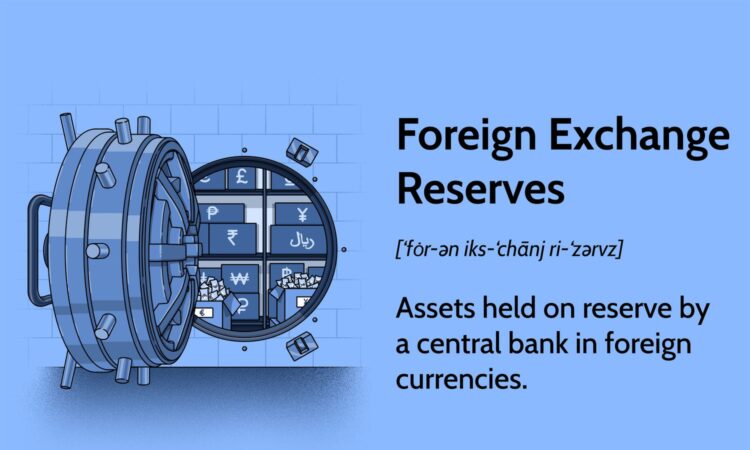
What Are Foreign Exchange Reserves?
Foreign exchange reserves are assets that are denominated in a foreign currency held by a central bank. These reserves are used to back liabilities and influence monetary policy.
Foreign exchange reserves can include banknotes, deposits, bonds, treasury bills, and other government securities. These assets serve many purposes but are most significantly held to ensure that a central government agency has backup funds if their national currency rapidly devalues or becomes entirely insolvent.
Key Takeaways
- Foreign exchange reserves are assets denominated in a foreign currency that are held by a nation’s central bank.
- These may include foreign currencies, bonds, treasury bills, and other government securities.
- Most foreign exchange reserves are held in U.S. dollars, with China being the largest foreign currency reserve holder in the world.
- Economists suggest that it’s best to hold foreign exchange reserves in a currency that is not directly connected to the country’s own currency.
How Foreign Exchange Reserves Work
It is a common practice in countries around the world for a central bank to hold a significant amount of reserves in its foreign exchange. Most of these reserves are held in the U.S. dollar since it is the most traded currency in the world. It is not uncommon for the foreign exchange reserves to be made up of the British pound (GBP), the euro (EUR), the Chinese yuan (CNY) or the Japanese yen (JPY) as well.
Economists assert that it is prudent to hold foreign exchange reserves in a currency that is not directly linked to a country’s own currency, in order to provide a barrier should there be a market shock. However, this practice has become more difficult as currencies have become increasingly intertwined as global trading has become easier.
Foreign exchange reserves are not only used to back liabilities but also influence monetary policy.
Example of Foreign Exchange Reserves
The world’s largest current foreign exchange reserve holder is China, a country holding more than $3 trillion of its assets in a foreign currency. Most of its reserves are held in the U.S. dollar. Such an arrangement makes international trade easier to execute since most of the trading takes place using the U.S. dollar.
Saudi Arabia also holds considerable foreign exchange reserves, as the country relies mainly on the export of its vast oil reserves. If oil prices begin to rapidly drop, the country’s economy could suffer. It keeps large amounts of foreign funds in reserves to act as a cushion should this happen.
U.S. foreign exchange reserves totaled over $244 billion as of the last week of July 2024.
Russia’s foreign exchange reserves are held mostly in U.S. dollars, much like the rest of the world, but the country also keeps some of its reserves in gold. Since gold is a commodity with an underlying value, the risk in relying on gold in the event of a Russian economic decline is that the value of gold will not be significant enough to support the country’s needs. As of February 2022, Russia’s foreign exchange reserves totaled some $630 billion. However, sanctions imposed by the European Union (EU), the U.S., and other nations in response to Russia’s invasion of Ukraine in February 2022 rendered most of those reserves inaccessible to the central bank.
Another danger of using gold as a reserve is that the asset is only worth what someone else is willing to pay for it. During an economic crash, that would put the power of determining the value of the gold reserve, and therefore Russia’s financial fallback, into the hands of the entity willing to purchase it.
How Much in U.S. Treasuries Does China Hold?
As of May 2024, China held $768.3 billion in U.S. Treasury securities, making it the second-largest foreign holder of U.S. debt after Japan.
Who Has the Largest Foreign Exchange Reserves in the World?
According to an analysis of foreign exchange reserves, China has the largest foreign exchange reserve in the world, holding over $3.6 trillion. Japan came in second, holding $1.3 trillion, and Switzerland followed with $890 billion.
How Much Money Total Is Held in Foreign Exchange Reserve?
According to the latest available data, the total value of all foreign exchange reserves equaled nearly $12.35 trillion dollars in the first quarter of 2024. That number represents a slight increase from the same period in 2023.
The Bottom Line
Foreign exchange reserves are foreign-denominated assets held by a central bank for the purpose of backing liabilities and influencing monetary policy.
Foreign exchange reserves can take many forms, including cash and bonds. They can provide a buffer in times of crisis, should a country’s own currency lose value.
China currently holds the world’s biggest foreign exchange reserve.


